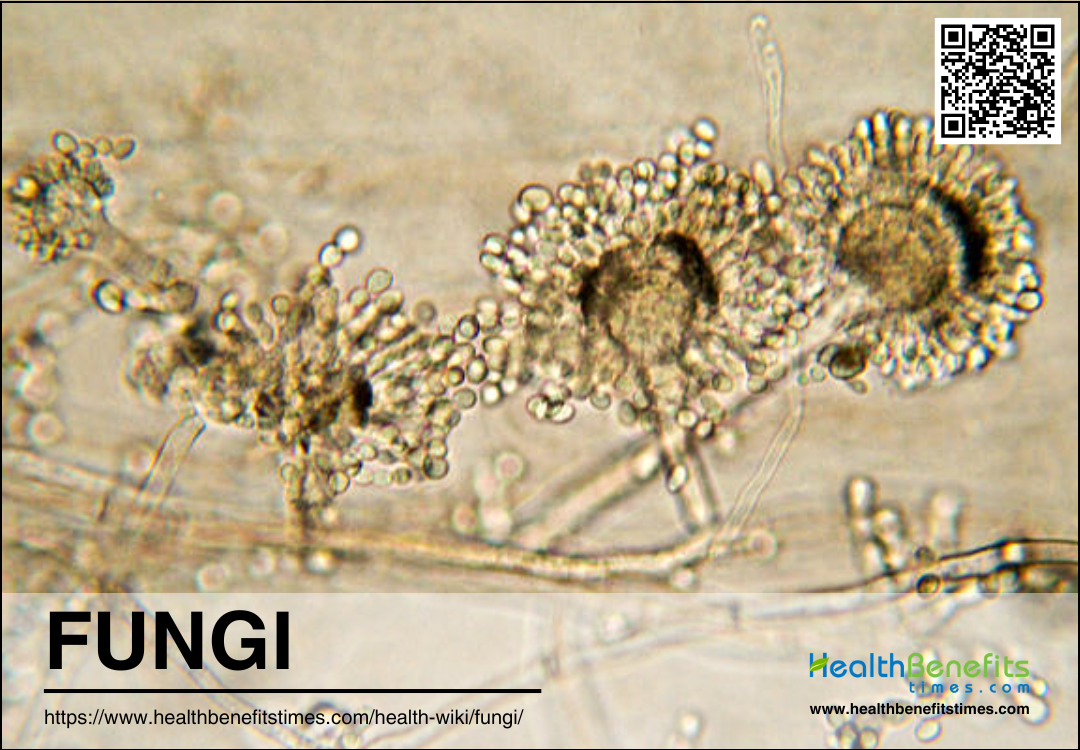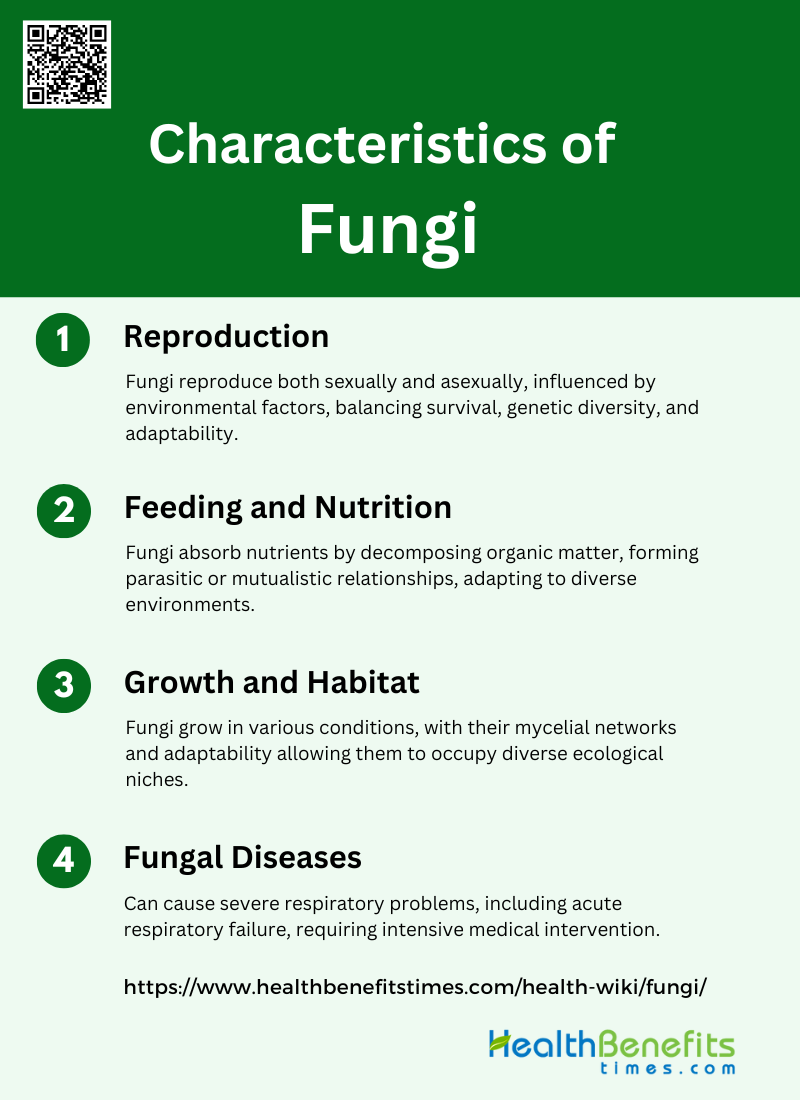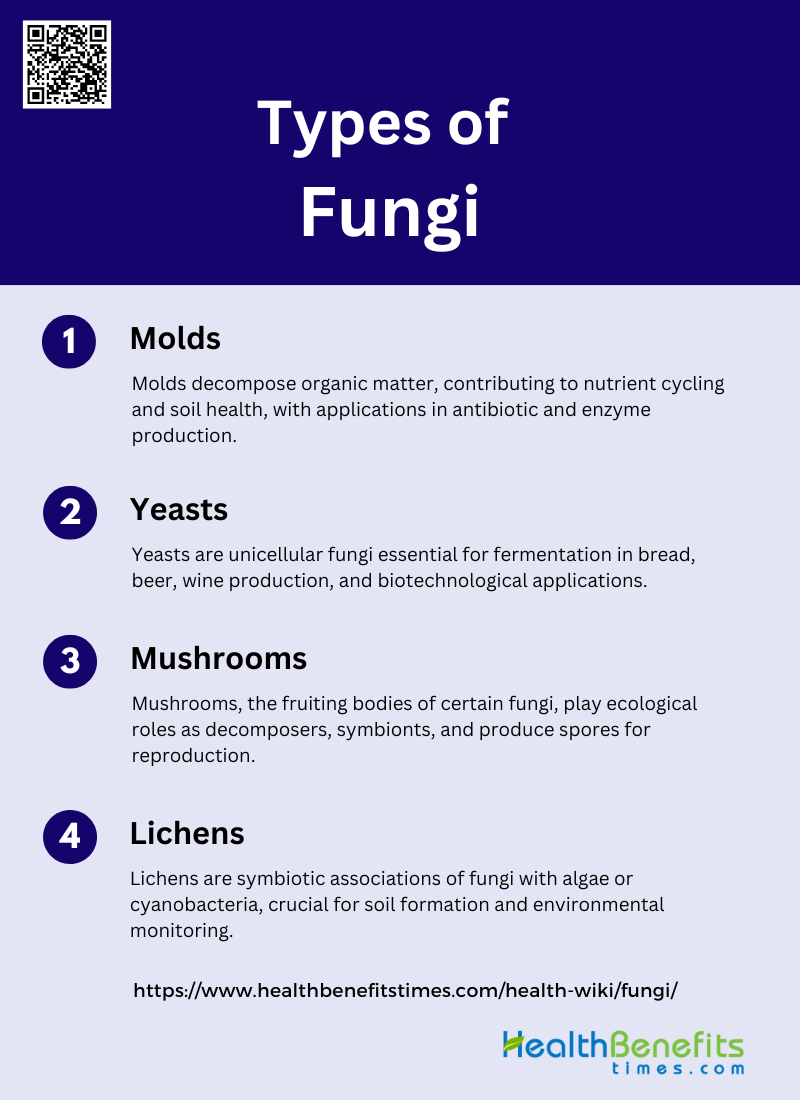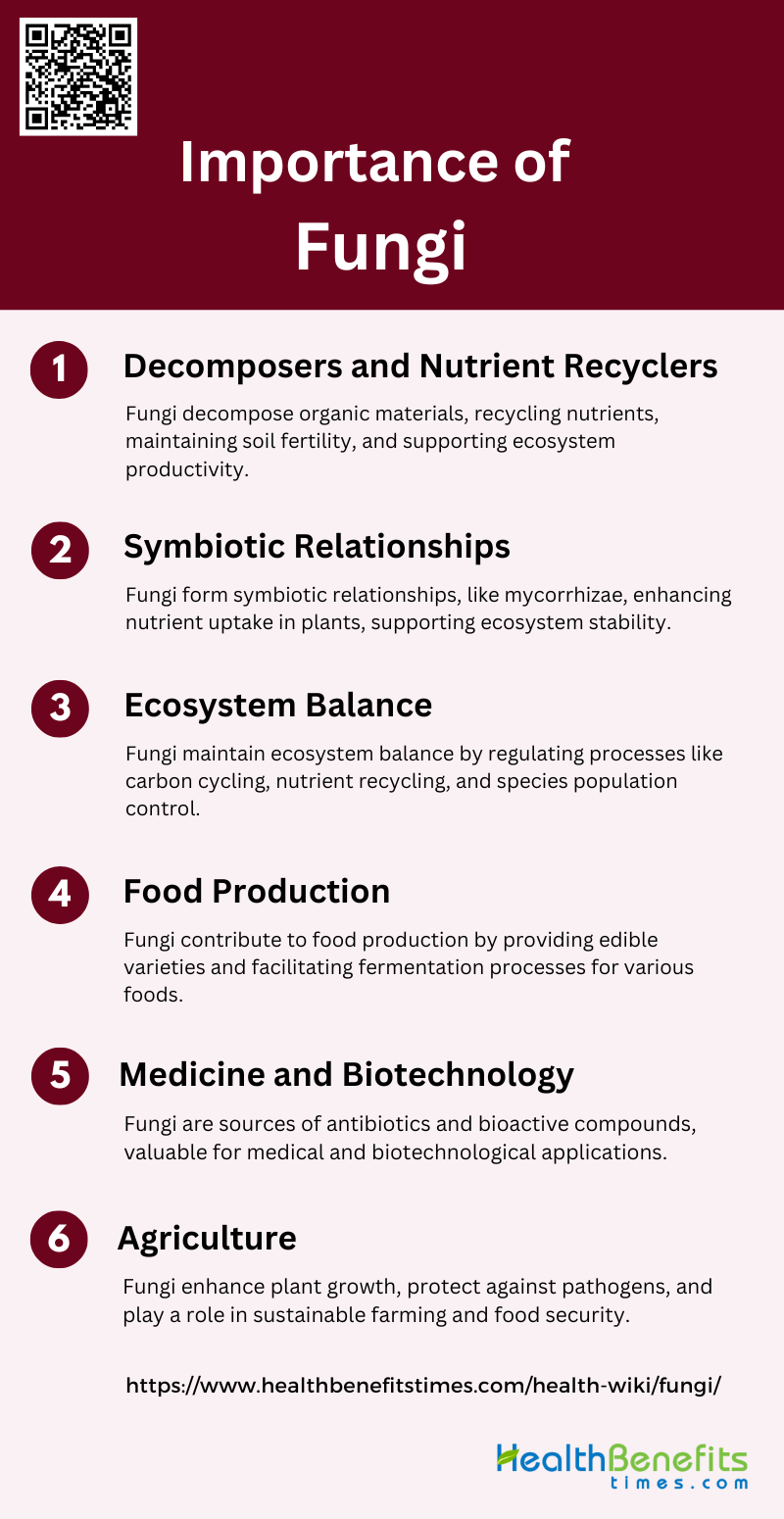Fungi are a diverse group of eukaryotic organisms that play crucial roles in various ecosystems. They are distinct from plants, animals, and bacteria, characterized by their unique cellular structure, which includes a cell wall made of chitin. Fungi can be unicellular, like yeasts, or multicellular, like molds and mushrooms. They obtain nutrients through absorption, often decomposing organic matter, which makes them essential for nutrient cycling in the environment. Additionally, fungi form symbiotic relationships with plants (mycorrhizae) and can also be pathogenic to plants and animals. Their ability to produce spores allows them to reproduce and spread efficiently in various habitats.
Characteristics of Fungi
Fungi are a diverse group of organisms that play crucial roles in various ecosystems. They exhibit unique characteristics in their reproduction, feeding, growth, and interactions with other organisms. Below are some key characteristics of fungi:
1. Reproduction
Fungi exhibit both asexual and sexual reproduction, with the choice often influenced by environmental conditions. Asexual reproduction typically involves the formation of spores, which are highly variable and stress-resistant, aiding in dispersal and survival during adverse conditions. Sexual reproduction, although less common, is linked to genetic diversity and adaptation, with some fungi capable of both modes depending on nutrient availability and environmental cues. The regulatory mechanisms for these processes can vary significantly among different fungal species, reflecting their evolutionary adaptations.
2. Feeding and Nutrition
Fungi are primarily saprophytic, decomposing organic matter to absorb nutrients, which is facilitated by their mycelial structure that maximizes surface area for nutrient absorption. They also engage in parasitic and mutualistic relationships; for instance, some fungi form mutualistic associations with insects, providing nutrition and protection in exchange for dispersal and substrate provision. These interactions highlight the ecological versatility of fungi, allowing them to thrive in diverse environments by forming complex relationships with other organisms.
3. Growth and Habitat
Fungi grow optimally in moist, nutrient-rich environments, but they exhibit remarkable adaptability to various conditions. Their mycelial networks enable efficient colonization of substrates, and they can form specialized structures like fruiting bodies for reproduction. Environmental factors such as light, temperature, and nutrient availability significantly influence fungal growth and development, with some species showing highly labile metabolic responses to different nutritional environments. This adaptability allows fungi to occupy a wide range of ecological niches.
4. Fungal Diseases
Fungi can cause a variety of diseases in humans, plants, and animals. Common human infections include athlete’s foot and candidiasis, while plant diseases caused by fungi can lead to significant agricultural losses. Prevention and treatment methods include antifungal medications for humans and fungicides for plants, as well as practices like crop rotation and resistant plant varieties to manage plant diseases. Understanding the biology and environmental interactions of fungi is crucial for developing effective control strategies.
Types of Fungi
Fungi are a diverse group of organisms that play essential roles in various ecosystems. They can be found in almost every environment on Earth, from soil and water to plants and animals. Below are some common types of fungi and their unique characteristics and roles in nature.
1. Molds
Molds are filamentous fungi that play a crucial role in the decomposition and recycling of organic matter. They are commonly found in various environments, including soil, decaying vegetation, and even indoor settings. Molds break down complex organic substances into simpler compounds, thereby contributing to nutrient cycling in ecosystems. This decomposition process is essential for maintaining soil health and fertility. Additionally, molds have significant industrial applications, such as in the production of antibiotics and enzymes.
2. Yeasts
Yeasts are unicellular fungi that are vital in fermentation processes, including the production of bread, beer, and wine. These fungi convert sugars into alcohol and carbon dioxide, a process that has been harnessed by humans for millennia. Yeasts are found in diverse environments, from soil and water to the surfaces of plants and animals. They are also used in biotechnology for the production of biofuels and pharmaceuticals. The species Saccharomyces cerevisiae is particularly well-known for its role in baking and brewing.
3. Mushrooms
Mushrooms are the fruiting bodies of certain fungi, primarily from the phyla Basidiomycota and Ascomycota. They play a key role in the reproduction of these fungi by producing and dispersing spores. Mushrooms can be found in various habitats, including forests, grasslands, and urban areas. They are classified into edible and poisonous varieties, with species like Agaricus bisporus being commonly consumed, while others like Amanita phalloides are highly toxic. Mushrooms also have ecological importance as decomposers and symbionts.
4. Lichens
Lichens are a symbiotic relationship between fungi and algae or cyanobacteria. They are found in diverse environments, from arctic tundras to tropical rainforests, and play a crucial role in ecosystems by contributing to soil formation and serving as bioindicators of environmental health. Lichens are highly sensitive to air pollution and climate change, making them valuable for monitoring environmental changes. They also provide habitat and food for various organisms.
Importance of Fungi
Fungi are vital to the health of our ecosystems and have numerous applications in human industries. They contribute to nutrient cycling, decompose organic matter, and form symbiotic relationships with plants. Below is some key Importance of Fungi:
1. Decomposers and Nutrient Recyclers
Fungi play a crucial role as decomposers and nutrient recyclers in ecosystems. They break down complex organic materials such as cellulose and lignin found in plant debris, converting them into simpler compounds that can be reused by other organisms. This decomposition process is vital for the cycling of carbon and nutrients, maintaining soil fertility and ecosystem productivity. By decomposing dead organic matter, fungi release essential nutrients back into the soil, which are then available for uptake by plants, thus sustaining the nutrient cycle. Their ability to penetrate solid substrates with hyphae and disperse spores over long distances further enhances their efficiency as decomposers.
2. Symbiotic Relationships
Fungi form various symbiotic relationships with plants, animals, and other organisms, significantly impacting ecosystem dynamics. Mycorrhizal fungi, for instance, establish mutualistic associations with plant roots, enhancing water and nutrient uptake, particularly phosphorus, while receiving carbon-rich compounds in return. These symbiotic relationships are essential for the growth and productivity of most terrestrial plants, including major agricultural crops. Additionally, fungi form lichens with cyanobacteria and green algae, contributing to nutrient cycling and ecosystem stability. These symbiotic interactions highlight the integral role of fungi in supporting plant health and ecosystem resilience.
3. Ecosystem Balance
Fungi are fundamental to maintaining ecosystem balance through their roles as decomposers, symbionts, and pathogens. They regulate key ecosystem processes such as carbon cycling, nutrient recycling, and soil formation. By decomposing organic matter, fungi contribute to soil health and fertility, which supports plant growth and biodiversity. Symbiotic fungi, like mycorrhizae, enhance plant resilience to environmental stresses, promoting ecosystem stability. Conversely, pathogenic fungi can control plant and animal populations, influencing species composition and community dynamics. Thus, fungi are indispensable for ecosystem functioning and balance.
4. Food Production
Fungi have been utilized in food production for centuries, contributing to the creation of various food products and beverages. Edible fungi, such as mushrooms, truffles, and morels, are highly valued for their nutritional and culinary qualities. Fungi are also essential in the fermentation processes used to produce bread, beer, wine, and cheese, where they help in developing flavors and textures. Additionally, fungi are employed in the production of enzymes and other biochemicals that enhance food processing and preservation. Their diverse applications in food production underscore their economic and cultural importance.
5. Medicine and Biotechnology
Fungi have made significant contributions to medicine and biotechnology. They are the source of numerous antibiotics, such as penicillin, which have revolutionized modern medicine by treating bacterial infections. Fungi also produce other medically important compounds, including immunosuppressants and cholesterol-lowering drugs. In biotechnology, fungi are used to produce enzymes, biofuels, and biopesticides, offering sustainable solutions for various industrial processes. Their ability to produce a wide range of bioactive compounds makes fungi invaluable in developing new therapies and biotechnological applications.
6. Agriculture
In agriculture, fungi play both beneficial and detrimental roles. Mycorrhizal fungi enhance plant growth and productivity by improving nutrient and water uptake, particularly under stressful conditions such as drought or poor soil fertility. They also help in protecting plants from pathogens, thereby reducing the need for chemical pesticides. However, some fungi are plant pathogens that cause diseases, leading to significant crop losses and economic impact. Understanding and managing the roles of fungi in agriculture is crucial for sustainable farming practices and food security.
Fascinating Fungal Facts
Fungi are among the most intriguing organisms on Earth, with unique characteristics and behaviors. They range from microscopic yeasts to large mushrooms and play crucial roles in ecosystems and human life. Below are some fascinating facts about fungi that highlight their diversity and importance.
1. Diverse Kingdom: The Kingdom Fungi includes molds, mushrooms, lichens, rusts, smuts, and yeasts. These eukaryotes have diverse life histories and make essential contributions to the biosphere, human industry, medicine, and research.
2. Haploid Genetics and Immortality: Many fungi have haploid genetics and those in cultivation are essentially immortal. These features make it easier to associate traits with genotype, even for complex traits, compared to other model organisms like Drosophila or Arabidopsis.
3. Genome Size: The typical fungal genome size of 30-40 Mb is small by eukaryotic standards. This has made fungi leading models for eukaryote genome sequencing, with over 100 assembled genome sequences available.
4. Evolutionary History: About a billion years ago, a population of aquatic, unicellular eukaryotes split into two lineages: one gave rise to animals, and the other to fungi. This close evolutionary relationship makes fungi exceptional models for studying mammalian biology.
5. Pathogenic Diversity: Fungi are found in almost every environmental niche and play crucial roles in global biogeochemical cycles. While most fungi are not pathogenic, some species cause infections in humans and plants, ranging from superficial to life-threatening.
6. Cell Wall Complexity: Fungal cell walls protect them from environmental stresses and must remodel to allow for growth and division. This cell wall also connects fungi with their environment by triggering intracellular signaling pathways and mediating adhesion to other cells and extracellular matrices.
7. Species Richness: Recent estimates suggest there are between 2.2 and 3.8 million fungal species, but only about 100,000 species have been described. This indicates that a vast number of fungal species remain undiscovered.
8. Genomic Insights: Large-scale genomic projects have produced extensive catalogs of fungal genes and genomic organization. These datasets help understand how fungi adapt to their environments and ecological niches.
9. New Phylum: The arbuscular mycorrhizal (AM) fungi, crucial for the ecology and physiology of land plants, have been placed into a new monophyletic phylum, the Glomeromycota. This reclassification provides a basis for a new and natural systematics of these organisms.
10. Toxins and Immunity: Certain fungi produce mycotoxins in response to environmental conditions, which can have deleterious health impacts when ingested. Fungal toxins also play a role in modulating host immune responses during infections.
FAQs
1. What are the main differences between fungi and plants?
Unlike plants, fungi do not have chlorophyll and cannot perform photosynthesis. Fungi obtain nutrients through absorption, while plants use sunlight to produce food. Fungal cell walls are made of chitin, whereas plant cell walls are composed of cellulose.
2. How do fungi contribute to soil health?
Fungi decompose organic matter, breaking down complex molecules like cellulose and lignin into simpler substances. This process enriches the soil with nutrients, promotes soil structure, and enhances water retention, supporting plant growth and overall ecosystem health.
3. Can fungi survive in extreme environments?
Yes, certain fungi, known as extremophiles, can survive in extreme environments such as high temperatures, high salinity, or acidic conditions. For example, fungi have been found in deep-sea hydrothermal vents and arctic ice.
4. What is the difference between saprophytic and parasitic fungi?
Saprophytic fungi decompose dead organic material to absorb nutrients, playing a key role in nutrient recycling. Parasitic fungi, on the other hand, obtain nutrients by infecting and living off a host organism, which can be a plant, animal, or even another fungus.
5. How do fungi affect climate change?
Fungi contribute to both carbon sequestration and release in ecosystems. Decomposer fungi break down organic matter, releasing carbon dioxide, while mycorrhizal fungi store carbon in the soil by facilitating plant growth and the formation of stable soil aggregates.
6. What are endophytic fungi, and what role do they play in plants?
Endophytic fungi live inside plant tissues without causing harm. They can enhance plant growth by improving nutrient absorption, providing protection against pathogens, and increasing the plant’s tolerance to environmental stressors like drought and heavy metals.
7. Are there fungi that can degrade plastics?
Yes, certain fungi, such as Aspergillus tubingensis and Pestalotiopsis microspora, have been found to degrade synthetic polymers like plastics. These fungi produce enzymes that break down the plastic polymers into simpler molecules, offering potential for bioremediation.
8. What are the potential risks of using fungi in agriculture?
While beneficial fungi can improve soil health and plant growth, some fungi can also cause plant diseases, leading to significant crop losses. The use of fungi in agriculture requires careful management to balance the benefits with the potential risks of pathogenic fungi.
9. How do antifungal drugs work, and what are some common types?
Antifungal drugs work by targeting specific components of fungal cells, such as the cell membrane or cell wall. Common types include azoles (like fluconazole), which inhibit the synthesis of ergosterol (a key cell membrane component), and echinocandins, which inhibit cell wall synthesis.
10. What are mycotoxins, and how can they affect human health?
Mycotoxins are toxic compounds produced by certain fungi, which can contaminate food crops. They pose significant health risks, including liver damage, immune suppression, and cancer. Common mycotoxins include aflatoxins, ochratoxins, and fumonisins.





